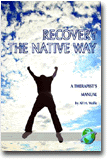
Recovery the Native Way
A Therapist's Manual
By:
Dr. Alf H. Walle, Erskine College
Published 2008
In recent years, there has been a growing awareness that Native clients who suffer from substance abuse often face challenges that are distinct from those experienced by the mainstream population. For a number of years, I have been involved in research involving Native alcoholism and I have recently published a book on the subject titled The Path of Handsome Lake: A Model of Recovery for Native People. My book argues that many different Native cultures (in America and elsewhere) face similar challenges and disruptions because their cultures are often under great stress and/or because people are alienated from their heritage. The dyfunctional responses of many different Native people are similar because they are subjected to similar pressures. In a nutshell, due to contact with the outside world, Native cultures often experience disruptive transitions, and (in some instances) entire cultures or ways of life may face extinction. Under such circumstances, the culture loses the ability to support people and help them cope with the pressures of life. Cultural decline itself often causes additional trauma. Combined, these pressures can trigger dysfunction within the Native community. The obvious antidote for such maladies is to help Native substance abusers to reconnect with their heritage in positive and constructive ways. My earlier book and this one are inspired by the life and work of nineteenth century Iroquois leader Handsome Lake who developed a method to help Native people embrace their heritage as they recovered from substance abuse. Because my earlier book was scholarly and not focused on practitioner issues, using it within a therapeutic context may be difficult. Here, I adapt my ideas so they can be applied to therapy in a systematic and productive manner. The total program of therapy is presented in three volumes. The first is a short overview of the program that has been written at about a 10th-grade reading level. My goal is to provide a wide range of clients (as well as those who pursue self-help work) with an easily understood description of the program. The second document is a consumable workbook designed to be used with the reader. The workbook can be used both within the context of therapy and by those seeking strategies of self-help. The volume you are reading is a guide for therapists to consult when using this method to help Native clients. It is hoped that all three of these texts will play a significant role in the therapy and recovery of Native substance abusers.
CONTENTS
Foreword, Preface, Acknowledgments, Prologue To Part 1, Chapter 1: Substance Abuse And Native People, Prologue To Part 2 Chapter 2: The Handsome Lake Method: An Introduction, Chapter 3: Strategies Of Intervention, Chapter 4: Suggestions For Therapy, Prologue To Part 3, Chapter 5: Adjusting The Dsm Diagnostic Criteria To Deal With Native Clients, Chapter 6:the Process And Strategies Of Diagnosis, Chapter 7: Sample Treatment Plans, Conclusion, Appendix: Posters Of The Path And Landmarks

- EDU015000 - EDUCATION: Higher
- EDU037000 - EDUCATION: Research
- SEL006000 - SELF HELP: SUBSTANCE ABUSE & ADDICTIONS: Alcoholism
-
 (Re)Envisioning Social Studies Education Research
Current Epistemological and Methodological Expansions, Deconstructions, and Creations
(Re)Envisioning Social Studies Education Research
Current Epistemological and Methodological Expansions, Deconstructions, and Creations
-
 Affirming Identity, Advancing Belonging, and Amplifying Voice in Sororities and Fraternities
Affirming Identity, Advancing Belonging, and Amplifying Voice in Sororities and Fraternities
-
 Effective Alternative Assessment Practices in Higher Education
Effective Alternative Assessment Practices in Higher Education
-
 Expanding the Vision of Faculty Learning Communities in Higher Education
Emerging Opportunities for Faculty to Engage Each Other in Learning, Teaching, and Support
Expanding the Vision of Faculty Learning Communities in Higher Education
Emerging Opportunities for Faculty to Engage Each Other in Learning, Teaching, and Support
-
 Institutional Diversity in American Postsecondary Education
Institutional Diversity in American Postsecondary Education
-
 Promoting Equitable Classroom Practices in Higher Education
Approaches Beyond Curriculum
Promoting Equitable Classroom Practices in Higher Education
Approaches Beyond Curriculum
-
 The Handbook for Aspiring Higher Education Leaders
The Handbook for Aspiring Higher Education Leaders

